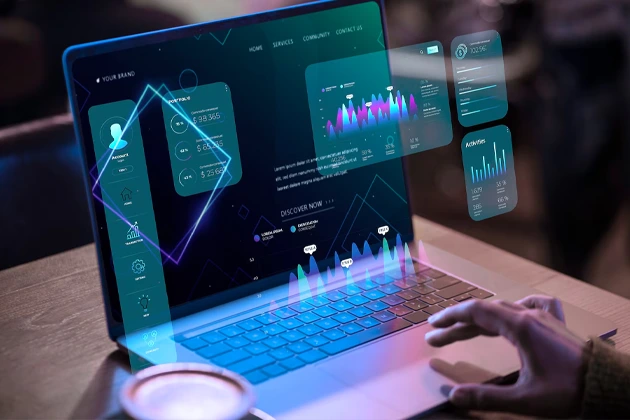Digital transformation has altered the picture of businesses across the globe in the last few decades. As technological advancement continues sweeping industries, enterprises have focused on empowering their IT infrastructure. With IT digital transformation in progress, the need to strengthen cybersecurity has also increased. The rapid pace of digitalization has exposed vulnerabilities in systems, data, and networks to threat, maximizing the need to safeguard information technology security extensively.
This article delves into the complex landscape of IT security as digital transformation continues to evolve with time.
Decoding Information Technology
Information technology has become an indispensable component in shaping enterprise capabilities to respond to change. The term information technology encompasses the use of hardware, software, networking, and infrastructure to collect, manage, analyze, and share information for specific purposes. The undeniable contribution of IT in embracing new technologies and systems should be considered while apprehending IT digital transformation. The more robust the IT infrastructure of an organization, the easier it gets to amplify digital transformation.
Unveiling IT Digital Transformation
Revitalizing and reshaping an organization to create value through technology deployment is the true essence of digital transformation. Information technology is the founding force of digital transformation as it helps in implementing and rescaling technological adaptations. The purpose of IT digital transformation is to brace the existing IT infrastructure to ensure all technological solutions are deployed efficiently in alignment with organizational objectives. The success of organizational digitalization largely depends on its IT infrastructure’s capabilities.
Role of IT in Digital Transformation
An organization’s information technology is the cornerstone of its digital transformation process. The role of IT in digital transformation is extensive, and to better understand its nature, we need to evaluate the roles that IT plays in accelerating digitization.
- The IT infrastructure works to implement and evaluate new technologies required for a digital transformation. IT digital transformation ensures that the adopted technological solutions are in alignment with business objectives.
- Implemented IT solutions serve as the pillars for developing new systems and processes that can enhance efficiency and productivity.
- The matter of information technology security surfaces with the adoption of new technologies during organizational digital transformation. In order to protect the IT assets of an organization, efficient IT solutions must be facilitated to ensure security.
- An IT infrastructure promotes interoperability and collaboration throughout an organization. During a digital transformation, collaboration is enhanced to maximize operational benefits.
Discoursing Information Technology Security
A range of strategies designed to protect organizational digital assets, networks, and data refers to information technology security. As IT digital transformation has intensified in the last few years, the frequency of cyberattacks, unauthorized access to data, and other malicious activities have also increased. These security threats have promoted the need to amplify IT security as an act to safeguard IT systems, networks, data, and processes. Ransomware, viruses, spyware, phishing, and more are some substantial threats to IT security, and to combat them, actionable security practices are to be executed within the IT realm of an organization.
The Impact of IT Digital Transformation on IT security
Digital transformation, with its multi-faceted benefits, also comes with a range of challenges, and information technology security is one of its biggest challenges. Let us understand how digital transformation impacts information technology security.
-
Creates a Preferable Environment for Cybercrimes
An ongoing IT digital transformation assigns more tasks to computers and links them with each other. The web of connection creates a favorable situation for hackers, unauthorized persons, and cyber attackers to penetrate the systems maliciously, increasing data theft, disclosure, and unauthorized data sharing for criminal activities.
-
Risks Coming Up with Third-Party Services
Nowadays, organizations rely on third-party services such as cloud providers, IoT, process automation, and others to accelerate digital transformation. Entrusting organizational data to third parties exposes businesses to security issues like breaches and unauthorized access.
-
Difficulty in Scaling a Risk-Aware Culture
With rapid digital transformation in today’s competitive business world, it has become important to educate employees concerning various IT security and cybersecurity issues. As IT digital transformation becomes a customary practice, employees or staff must be well aware of potential security threats, social engineering activities, and effective measures to combat security issues.
Having said that, it is still very difficult to scale a risk-aware culture. As digital transformation increases conflicts between C-suite and IT security executives, the task becomes more difficult.
-
Increased Complexities in Managing and Controlling IT operations
In the wake of digital transformation, IT operations have become more complex as many tech-driven solutions are being adopted. The more technology a company adopts, the more complexities occur in managing and regulating those technologies. In such a scenario, information technology security often gets compromised as it becomes challenging to manage potential or occurring security threats.
Protecting IT Security in the Era of Digitalization
As information technology security gets exposed to internal and external threats like phishing attacks, unauthorized access, ransomware, and more, the need to protect that security heightens. Below are some effective IT security measures that palliate the IT digital transformation processes.
- Encryption: Converts information into ciphertext to ensure only authorized people have the key to access it.
- Firewalls: Monitor and control network traffic through predetermined security rules for safe data transfers.
- Access Control: Restricts access to sensitive information to authorized users only.
- Strong Password: A strong password makes decoding the credentials difficult for hackers or cyber attackers.
- Updates: Regular updates of programs and systems eliminate chances of security breaches to a certain extent.
- Security Software: Security software protects systems from internal and external threats.
Conclusion
With the advent of IT digital transformation, information technology security has encountered several challenges. The need for robust IT infrastructure increased for organizations undergoing digital transformation to make sure information is safe and secured. From this need, several IT security practices have surfaced to protect the IT security system and ease a digital transformation.










